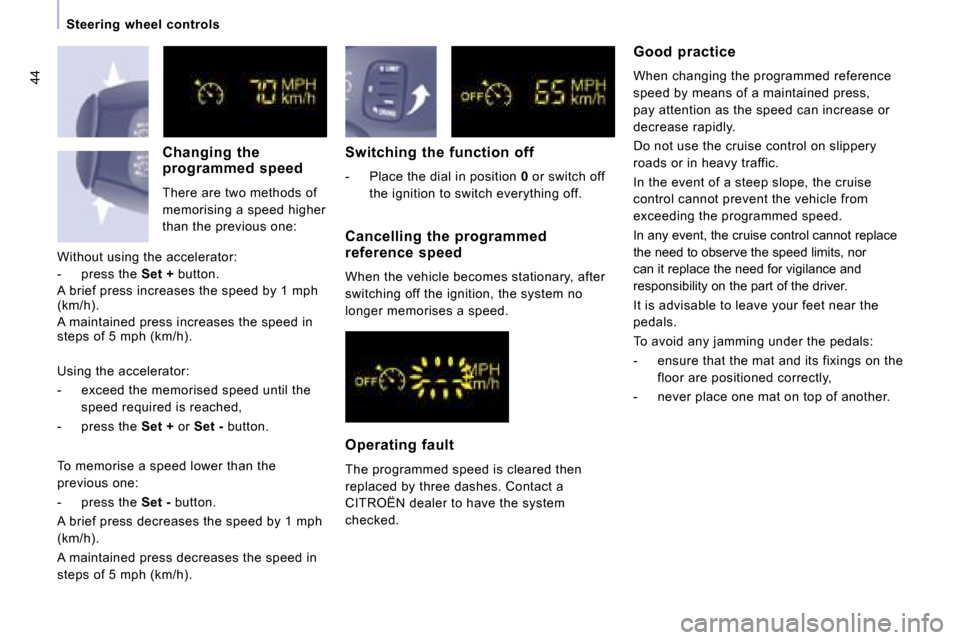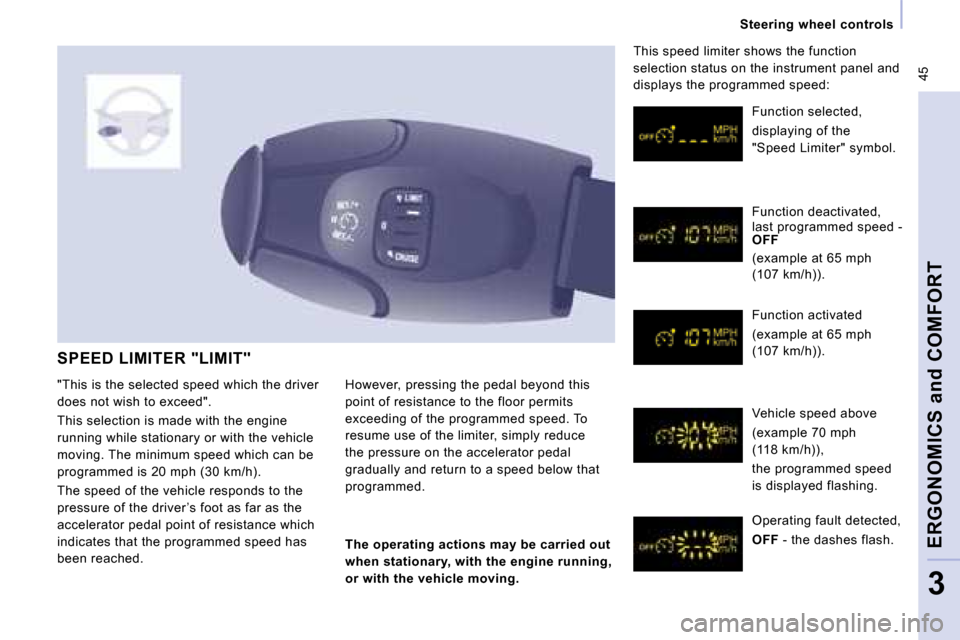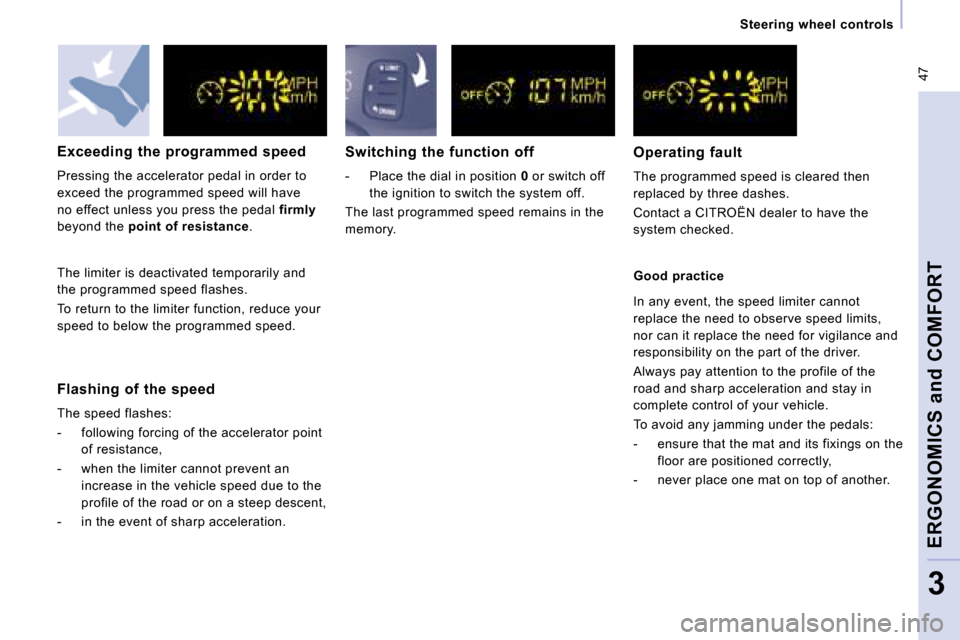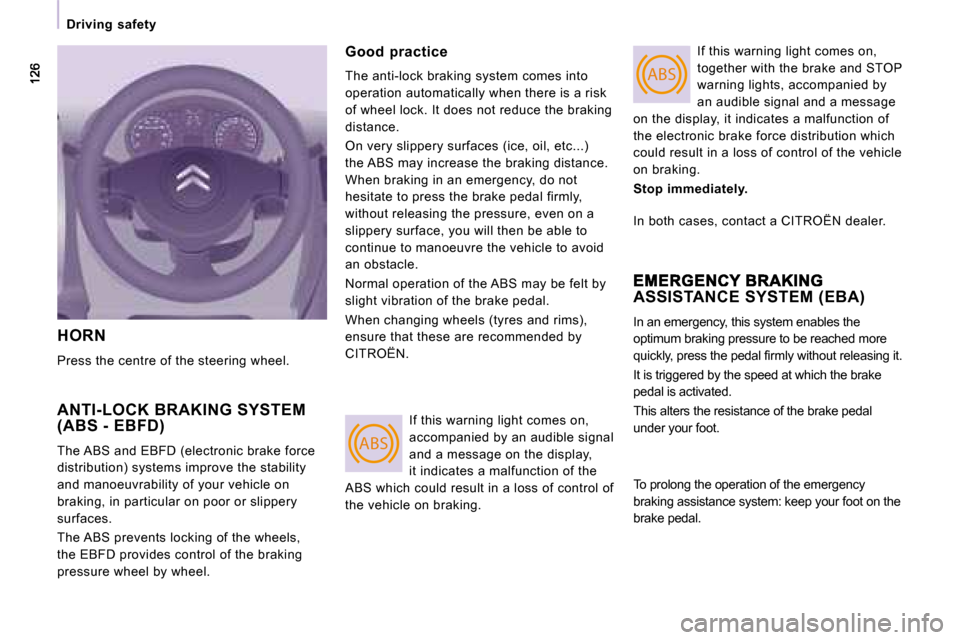steering wheel Citroen JUMPY 2008.5 2.G User Guide
[x] Cancel search | Manufacturer: CITROEN, Model Year: 2008.5, Model line: JUMPY, Model: Citroen JUMPY 2008.5 2.GPages: 185, PDF Size: 6.66 MB
Page 43 of 185

41
Steering wheel controls
ERGONOMICS and COMFORT
3
Special position of the windscreen
wipers
In the minute following switching off of the
ignition, any action on the stalk positions the
wipers against the windscreen uprights. This action enables you to position the
wiper blades for winter parking, cleaning or
replacement.
Refer to the "Changing a windscreen
wiper blade" section of chapter 8.
When using an automatic car wash,
switch off the ignition to avoid
triggering of the automatic wiping.
In winter, it is advisable to wait for the
windscreen to completely clear of ice before
operating the automatic wipe.
Rear windscreen wiper
Turn the ring to the first notch. Rear windscreen wash
Turn the ring past the first notch:
the windscreen wash then the
windscreen wiper operate for a
fixed time.
In winter, in the event of a considerable
amount of snow or ice, switch on the
rear screen demister. Once de-icing is
complete, remove the snow or ice which has
accumulated on the rear wiper blade. You
can then operate the rear windscreen wiper.
To park the wipers in their normal position
after this has been done, switch on the
ignition and move the stalk.
Activation
Press the control downwards. Activation of
the function is accompanied by a message
on the display.
The automatic windscreen wipers function
must be reactivated if the ignition has been
switched off for more than one minute, by
pressing the stalk downwards.
Deactivation/Switching off
Place the windscreen wipers stalk in
position
I , 1 or 2 . Deactivation of the function
is accompanied by a message on the
display.
In the event of malfunction of the automatic
windscreen wipers, the windscreen wipers
will operate in intermittent mode.
Contact a CITROËN dealer to have the
system checked.
Page 44 of 185

42
Steering wheel controls
CRUISE CONTROL "CRUISE"
In order for it to be programmed or activated,
the vehicle speed must be greater than 25 mph
(40 km/h) with at least 4th gear engaged. Function selected,
displaying of the
"Cruise Control" symbol.
Function deactivated,
OFF (example at
107 km/h).
Function activated
(example at 107 km/h).
Vehicle speed above
(e.g. 118 km/h),
the programmed speed
is displayed flashing.
Operating fault detected,
OFF - the dashes flash.
This cruise control shows the function
selection status on the instrument panel and
displays the programmed speed:
"This is the speed at which the driver wishes
to drive".
This aid to driving in free-flowing traffic
enables the vehicle to maintain the speed
programmed by the driver, unless a steep
gradient makes this impossible.
Page 45 of 185

43
Steering wheel controls
ERGONOMICS and COMFORT
3
Selecting the function
- Place the switch in the CRUISE position.
The cruise control is selected but is
not yet active and no speed has been
programmed.
First activation/
programming a speed
- Reach the chosen speed by pressing the
accelerator.
- Press the SET - or
SET + button.
This programmes/activates the reference
speed and the vehicle will maintain this
speed. Temporary exceeding of the speed
It is possible to
accelerate and drive
momentarily at a speed greater than the
programmed speed. The value programmed
flashes.
When the accelerator pedal is released, the
vehicle will return to the programmed speed. Reactivation
- Following deactivation of the cruise
control, press this button.
Your vehicle will return to the last
programmed speed.
Alternatively, you can repeat the
"first activation" procedure.
Deactivation (off)
- Press this button or the brake or clutch pedal.
Page 46 of 185

44
Steering wheel controls Switching the function off
- Place the dial in position 0 or switch off
the ignition to switch everything off. Good practice
When changing the programmed reference
speed by means of a maintained press,
pay attention as the speed can increase or
decrease rapidly.
Do not use the cruise control on slippery
roads or in heavy traffic.
In the event of a steep slope, the cruise
control cannot prevent the vehicle from
exceeding the programmed speed.
In any event, the cruise control cannot replace
the need to observe the speed limits, nor
can it replace the need for vigilance and
responsibility on the part of the driver.
It is advisable to leave your feet near the
pedals.
To avoid any jamming under the pedals:
- ensure that the mat and its fixings on the
floor are positioned correctly,
- never place one mat on top of another.
Changing the
programmed speed
There are two methods of
memorising a speed higher
than the previous one:
Without using the accelerator:
- press the Set + button.
A brief press increases the speed by 1 mph
(km/h).
A maintained press increases the speed in
steps of 5 mph (km/h). Cancelling the programmed
reference speed
When the vehicle becomes stationary, after
switching off the ignition, the system no
longer memorises a speed.
Using the accelerator:
- exceed the memorised speed until the speed required is reached,
- press the Set + or Set - button.
To memorise a speed lower than the
previous one:
- press the Set - button.
A brief press decreases the speed by 1 mph
(km/h).
A maintained press decreases the speed in
steps of 5 mph (km/h). Operating fault
The programmed speed is cleared then
replaced by three dashes. Contact a
CITROËN dealer to have the system
checked.
Page 47 of 185

45
Steering wheel controls
ERGONOMICS and COMFORT
3
SPEED LIMITER "LIMIT"
However, pressing the pedal beyond this
point of resistance to the floor permits
exceeding of the programmed speed. To
resume use of the limiter, simply reduce
the pressure on the accelerator pedal
gradually and return to a speed below that
programmed. Function selected,
displaying of the
"Speed Limiter" symbol.
Function deactivated,
last programmed speed -
OFF
(example at 65 mph
(107 km/h)).
Function activated
(example at 65 mph
(107 km/h)).
Vehicle speed above
(example 70 mph
(118 km/h)),
the programmed speed
is displayed flashing.
Operating fault detected,
OFF - the dashes flash.
This speed limiter shows the function
selection status on the instrument panel and
displays the programmed speed:
The operating actions may be carried out
when stationary, with the engine running,
or with the vehicle moving.
"This is the selected speed which the driver
does not wish to exceed".
This selection is made with the engine
running while stationary or with the vehicle
moving. The minimum speed which can be
programmed is 20 mph (30 km/h).
The speed of the vehicle responds to the
pressure of the driver ’s foot as far as the
accelerator pedal point of resistance which
indicates that the programmed speed has
been reached.
Page 48 of 185

46
Steering wheel controls
Selecting the function
- Place the dial in the LIMIT position.
The limiter is selected but is not yet
active. The display indicates the last
programmed speed.
Programming a speed
A speed can be programmed without
activating the limiter but with the engine
running.
To memorise a speed higher than the
previous one:
- press the Set + button.
A brief press increases the speed by 1 mph
(km/h).
A maintained press increases the speed in
steps of 5 mph (km/h).
To memorise a speed lower than the
previous one:
- press the Set - button.
A brief press decreases the speed by 1 mph
(km/h).
A maintained press decreases the speed in
steps of 5 mph (km/h). Activation/Deactivation (off)
Pressing this button once activates the
limiter, pressing the button again deactivates
it (OFF).
Page 49 of 185

47
Steering wheel controls
ERGONOMICS and COMFORT
3
Flashing of the speed
The speed flashes:
- following forcing of the accelerator point of resistance,
- when the limiter cannot prevent an increase in the vehicle speed due to the
profile of the road or on a steep descent,
- in the event of sharp acceleration.
Exceeding the programmed speed
Pressing the accelerator pedal in order to
exceed the programmed speed will have
no effect unless you press the pedal
firmly
beyond the point of resistance .
Good practice
Operating fault
The programmed speed is cleared then
replaced by three dashes.
Contact a CITROËN dealer to have the
system checked.
The limiter is deactivated temporarily and
the programmed speed flashes.
To return to the limiter function, reduce your
speed to below the programmed speed. Switching the function off
- Place the dial in position
0 or switch off
the ignition to switch the system off.
The last programmed speed remains in the
memory.
In any event, the speed limiter cannot
replace the need to observe speed limits,
nor can it replace the need for vigilance and
responsibility on the part of the driver.
Always pay attention to the profile of the
road and sharp acceleration and stay in
complete control of your vehicle.
To avoid any jamming under the pedals:
- ensure that the mat and its fixings on the floor are positioned correctly,
- never place one mat on top of another.
Page 126 of 185

ABS
ABS
Driving safety
HORN
Press the centre of the steering wheel.
ANTI-LOCK BRAKING SYSTEM (ABS - EBFD)
The ABS and EBFD (electronic brake force
distribution) systems improve the stability
and manoeuvrability of your vehicle on
braking, in particular on poor or slippery
surfaces.
The ABS prevents locking of the wheels,
the EBFD provides control of the braking
pressure wheel by wheel. Good practice
The anti-lock braking system comes into
operation automatically when there is a risk
of wheel lock. It does not reduce the braking
distance.
On very slippery surfaces (ice, oil, etc...)
the ABS may increase the braking distance.
When braking in an emergency, do not
hesitate to press the brake pedal firmly,
without releasing the pressure, even on a
slippery surface, you will then be able to
continue to manoeuvre the vehicle to avoid
an obstacle.
Normal operation of the ABS may be felt by
slight vibration of the brake pedal.
When changing wheels (tyres and rims),
ensure that these are recommended by
CITROËN .
If this warning light comes on,
together with the brake and STOP
warning lights, accompanied by
an audible signal and a message
on the display, it indicates a malfunction of
the electronic brake force distribution which
could result in a loss of control of the vehicle
on braking.
Stop immediately.
ASSISTANCE SYSTEM (EBA)
In an emergency, this system enables the
optimum braking pressure to be reached more
�q�u�i�c�k�l�y�,� �p�r�e�s�s� �t�h�e� �p�e�d�a�l� �fi� �r�m�l�y� �w�i�t�h�o�u�t� �r�e�l�e�a�s�i�n�g� �i �t�.�
It is triggered by the speed at which the brake
pedal is activated.
This alters the resistance of the brake pedal
under your foot.
If this warning light comes on,
accompanied by an audible signal
and a message on the display,
it indicates a malfunction of the
ABS which could result in a loss of control of
the vehicle on braking. In both cases, contact a CITROËN dealer.
To prolong the operation of the emergency
braking assistance system: keep your foot on the
brake pedal.
Page 131 of 185

132
Air bags
Good practice
Sit in a normal upright position.
Wear a correctly adjusted seat belt.
Do not leave anything between the
occupants and the air bags (a child, pet,
object...). This could hamper the operation
of the air bags or injure the occupants.
After an accident or if the vehicle has been
stolen or broken into, have the air bag
systems checked.
All work on the air bag system is strictly
forbidden unless it is carried out by qualified
personnel of the CITROËN network.
Even if all of the precautions mentioned are
observed, a risk of injury or of minor burns
to the head, chest or arms when an air bag
is triggered cannot be ruled out. In fact, the
bag inflates almost instantly (within a few
milliseconds) then deflates within the same
time discharging the hot gas via openings
provided for this purpose. Side air bags
Only put recommended covers on the seats.
These will not hinder inflation of the side air
bags. Consult a CITROËN dealer.
Do not fix or glue anything to the seat backs.
This could cause injury to the chest or arms
when the side air bag inflates.
Do not sit with the upper part of the body
any nearer to the door than necessary.
Front air bags
Do not drive holding the steering wheel
by its spokes or resting your hands on the
centre part of the wheel.
Do not allow passengers to place their feet
on the fascia, they risk serious injury if the
air bag is triggered.
Smoke as little as possible as deployment of
the air bags can cause burns or the risk of
injury from a cigarette or pipe.
Never remove or pierce the steering wheel
or hit it violently.
Page 132 of 185

134
Air bags Disarming
The passenger ’s front air bag alone can be
disarmed:
- With the ignition switched off, insert
the key into the passenger air bag
disarming switch,
- turn it to the "OFF" position,
- then remove the key keeping the slot in this position.
Front air bags
The front air bags are incorporated in the
centre of the steering wheel for the driver
and in the fascia for the front passenger.
Reactivation
In the
"OFF" position, the passenger air
bag will not be triggered in the event of an
impact.
As soon as the child seat is removed, turn
the air bag slot to the "ON" position to
re-activate the air bag and thus ensure the
safety of your passenger in the event of an
impact. To ensure the safety of your child, it
is essential to disarm the passenger
air bag when you install a rear-facing child
seat on the front passenger seat. Otherwise,
the child would risk being killed or seriously
injured if the air bag were to inflate.
The air bag warning light on the
instrument panel is lit throughout
the period of disarming.
Activation
They are deployed simultaneously, unless
the passenger ’s front air bag has been
disarmed, in the event of a serious front
impact applied to all or part of the front
impact zone
A in the longitudinal centreline
of the vehicle on a horizontal plane directed
from the front towards the rear of the
vehicle.
The front air bag inflates between the front
occupant of the vehicle and the fascia to
cushion his forward movement. If this warning light comes on,
accompanied by an audible signal
and a message on the display,
contact a CITROËN dealer to
have the system checked.
Front air bag fault
If the two air bag warning lights are lit
continuously, do not install a
rear-facing child seat. Consult a CITROËN
dealer.